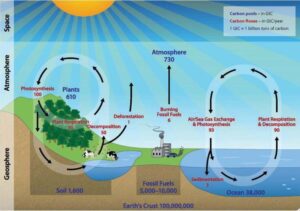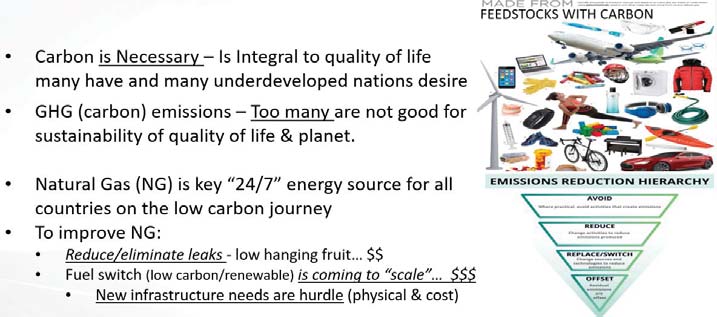Natural gas (NG), primarily methane (CH₄), plays an important role for our world as a raw material for a great variety of industrial processes and products. Its use as a primary energy source has increased through the last few decades due to its high hydrogen/carbon ratio, efficient combustion, and smaller impact to the environment, including lower carbon dioxide (CO₂) emissions.
By Tim Goedeker and Bronson Pate
The technological shift from other non-renewable carbon fuels (such as coal and oil) to natural gas in many sectors from electricity generation to heating systems (air & water) for homes has contributed to a considerable reduction in the carbon intensity and carbon footprint of energy production. Natural gas generates 50% fewer CO₂ emissions compared to coal and 30% less than heating oil. The transition to natural gas has been supported through the development of a supply chain consisting of exploration, production, transportation infrastructure (local, national, and transnational) gas grids, gasification plants and end-users.
Carbon
Before talking about “decarbonizing” or reducing carbon emissions, let’s take a moment to understand carbon and carbon emissions. Carbon, in its elemental form, is not harmful to the environment or human health. In fact, it is the building block, the chemical backbone, of all living organisms (humans, animals, plants) on Earth and plays an important role in the carbon cycle. Carbon compounds regulate the Earth’s temperature by absorbing & releasing CO₂, make up the food that sustains us, and provide energy that fuels our global economy.
The carbon cycle is the process by which CO₂ is absorbed and released among different parts of the Earth (air, water and land) which helps regulate the temperature on our Earth and ensures the ecosystems remain stable. The carbon cycle includes:
- Photosynthesis: plants absorb CO₂ from the atmosphere, convert it to organic matter and release oxygen into the atmosphere.
- Respiration: plants and animals release CO₂ back into the atmosphere through cellular respiration.
- Decomposition: dead plants, trees & animal matter are decomposed by microbes
and fungi releasing CO₂ back into the atmosphere. - Use of non-renewable carbon fuels & deforestation: CO₂ released from combustion of non-renewable carbon (fossil) and from deforestation can disrupt the natural balance of the carbon cycle leading to increased CO₂ in the atmosphere and the loss of biodiversity.

As seen in Figure 1, the oceans absorb approximately 40 times more CO₂ than the atmosphere (38,000 vs 730) and plants/tress/soil above 3 times more CO₂. Both are areas to explore for improving CO₂ uptake and reducing the excess CO₂ in the atmosphere. Concern arises when there are excess CO₂ emissions in the atmosphere. Increasing levels of CO₂ trap heat in the Earth’s atmosphere and cause the average temperature of the planet to rise above the natural balance from the carbon cycle.
The natural gas supply chain releases carbon emissions, greenhouse gases (GHG), to the atmosphere. Reducing the ‘absolute’ number and ‘intensity’ of the carbon emissions, commonly known as the carbon intensity (CI), throughout the NG supply chain is needed to reduce their impacts on the carbon cycle and the atmosphere. The term ‘carbon intensity’ refers to the amount of carbon dioxide (CO₂) and other key CO₂ ‘equivalent’ gasses (methane and nitrous oxide (N₂O)) emitted into the atmosphere. Intensity is typically reported as metric tons of ‘CO₂ equivalent’ per million standard cubic feet of gas (mt CO₂e/MMSCF).
Greenhouse gases can be emitted along the NG supply chain:
- Exploration & Production: potential release of methane through leaks from the wells and well production equipment.
- Processing: potential release of methane through equipment leaks, pump & compressor vents and safety flares.
- Transportation: potential release of methane along the pipeline and at compressor stations through flange, valve, compressor, and other equipment leaks.
- End-use: the release of carbon dioxide from the combustion of NG for building heating, water heating and electricity generation.
Emissions from natural gas exploration & production – methane and CO₂
Methane is a GHG with a global warming potential (GWP), or CO₂ ‘equivalency,’ 28 times higher than CO₂ over a 100-year time frame. This means 1 metric ton of methane has the same impact on the climate as 28 metric tons of CO₂.
Strategies to reduce methane emissions include:
- Regular monitoring and tracking of methane emissions will identify sources and inform efforts to reduce them. This may/will require upgrades to periodic or real-time sensing technology (fixed sensors, remote optical gas imaging cameras, etc.) because “if you can’t see the leaks, you can’t fix them.”
- Implementing best practices to reduce venting and flaring of NG at the production site.
- Implementing regular leak (fugitive) detection inspection and monitoring, including timely leak repair, and methane leaks and emissions will decline.

Strategies to reduce CO₂ emissions include:
- Installing or increasing the use of purchased electricity (scope 2 emissions) from low or no carbon intense (CI) energy sources such as wind, solar, nuclear and hydropower to power the exploration and production equipment.
- Improving the efficiency of the energy used (motors, pumps, compressors) will result in lower energy demand and lower emissions from the production of electricity (scope 2) emissions.
- Switching to renewable diesel for diesel powered equipment or replacing the non-renewable diesel-powered hydraulic fracturing equipment with low or no carbon sourced electric-powered alternatives (scope 1).
Emissions from natural gas processing and transportation
Strategies to reduce methane emissions include:
- Implementing low-emission technologies such as low-emission boilers, low-emission compressors, pumps, and valves will reduce emissions (scope 1) from natural gas separation & clean-up process operations.
- Upgrading pipeline infrastructure, compressors & valves with low or no emissions technology will reduce leaks and emissions (scope 1) from the transportation of NG.
Strategies to reduce CO₂ emissions include:
-

Figure 3. Natural gas supply chain – sources of GHGs. Improving pipeline infrastructure energy efficiency with the use of high-efficiency compressors, motors and engines will reduce facility energy consumption and can reduce emissions from the electrical supply source (scope 2).
- Implementing energy management systems with periodic or real- time monitoring and control of the mechanical systems can identify opportunities to optimize energy consumption for energy efficiency improvements.
- Integrating low or no carbon energy sources, such as hydro, nuclear, wind and solar power, into natural gas production operations can reduce emissions (scope 2) by reducing the amount of non-renewable carbon containing fuels used to power the operations.
Emissions from end-use of natural gas
Strategies to reduce CO₂ emissions include:
- Switching from the end-use of NG to electricity sourced from low or no carbon intense sources, such as wind, solar, nuclear and hydro can reduce emissions from the combustion (scope 3) of natural gas. However, there is a significant loss of thermal energy when switching from direct use of NG to the use of electricity. From an energy balance perspective, switching to electricity will require 2-3 times more energy (to make the electricity) to meet the comparable energy from NG.
- Incorporating renewable energy sources directly into the energy mix, such as renewable natural gas (RNG), derived from organic waste sources such as landfills, wastewater treatment plants, and agriculture can reduce GHG emissions. RNG has a lower carbon footprint than NG but has nearly the same energy content and its use can reduce GHG emissions.
- Switching to or integrating other low or no carbon fuels such as biogas, or hydrogen, into the NG energy mix could reduce emissions as well.
Reducing the carbon intensity of natural gas throughout the supply chain is necessary to help address the impact of increasing GHG emissions in the atmosphere. As highlighted in Figure 4, low or no carbon energy sources, and energy efficiency measures are important tools in this effort, and should be integrated into the natural gas supply chain’s tool box.

Investing in new technologies and practices will reduce greenhouse gas emissions, will reduce product loss (improve revenue) and may provide cost savings (improved energy efficiency). Our lives rely of Carbon and Energy (see Figure 5). US natural gas has the best reliability of supply, a high energy content and lowest GHG emissions of the non-renewable carbon fuels. Further reducing its carbon intensity and carbon emissions throughout the supply chain is necessary for it to remain the best fuel to address the energy “trilemma” (availability, sustainability, price) through this century.

About the authors

Tim has over 38 years of experience in refining operations, environmental compliance, engineering, economics, and strategic planning, including leadership roles in corporate environmental programs, refinery operations and project development. Prior to his retirement from Phillips 66 in 2022, he was accountable for implementing corporate wide programs to eliminate environmental regulatory non-compliance incidents, incorporate new federal environmental rules into the organization, and manage & minimize emissions (including GHGs) footprint, among others.
 Bronson Pate is currently the Environmental Consulting Manager for Teadit North America and the Director of Global Fugitive Emissions for MagDrive Techology. He has more than 15 years of experience dealing with regulatory and technical issues related to Leak Detection and Repair (LDAR) for numerous industries both here and abroad, specifically within refining, petrochemical and chemical industry plants.
Bronson Pate is currently the Environmental Consulting Manager for Teadit North America and the Director of Global Fugitive Emissions for MagDrive Techology. He has more than 15 years of experience dealing with regulatory and technical issues related to Leak Detection and Repair (LDAR) for numerous industries both here and abroad, specifically within refining, petrochemical and chemical industry plants.
References
EIA Carbon Dioxide Emissions Coefficients https://www.eia.gov/environment/emissions/co2_vol_mass.php
About this Featured Story
This Featured Story is an article from our Valve World Magazine, June 2023 issue. To read other featured stories and many more articles, subscribe to our print magazine. Available in both print and digital formats. DIGITAL MAGAZINE SUBSCRIPTIONS ARE NOW FREE.
“Every week we share a new Featured Story with our Valve World community. Join us and let’s share your Featured Story on Valve World online and in print.”




